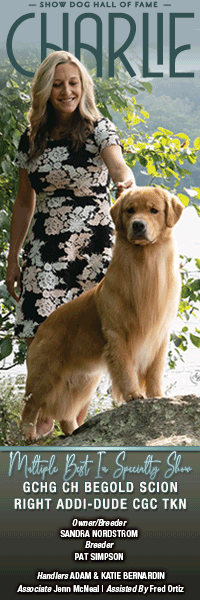Dog on a String
Click here to read the complete article
The Collar vs. Harness Debate
by Amy Fernandez
 The dog walking routine has cycled through countless fads and stages. And I’ve done it long enough to observe plenty of this unfolding drama. Back in prehistoric times, I was the lone dog walker pounding the pavement. Admittedly, I was considered the neighborhood eccentric. On the other hand, my only genuine concern came in the form of kamikaze raids by unleashed dogs.
The dog walking routine has cycled through countless fads and stages. And I’ve done it long enough to observe plenty of this unfolding drama. Back in prehistoric times, I was the lone dog walker pounding the pavement. Admittedly, I was considered the neighborhood eccentric. On the other hand, my only genuine concern came in the form of kamikaze raids by unleashed dogs.
Maybe we can credit good old Cesar Milan or the escalating message of dog owner responsibility, but somewhere along the line this antiquated custom returned to favor. And that’s a good thing. Legions of owners have rediscovered its multiple training/bonding/socialization benefits along with the fact that it’s generally enjoyable. Consequently, the time-honored terror of suburban neighborhoods – unleashed dogs – have become a rarity. And likewise, that’s a good thing.
All this should add up to a utopian dog walking experience, right? NOT! At 7:00 AM and PM, my streets are virtually gridlocked with platoons of conscientious owners with deliriously happy pets in tow; well…it’s usually the other way around. Wired up, determined dogs of every shape and size propel their hapless owners block after block.
You can probably guess where this is going. Regardless of breed or manageability, every dog wears a harness; typically in combination with a nice long retractable lead, equipment which provides virtually no control over these canine juggernauts, especially when unforeseen situations arise. Usually, the dog is well into its agenda of mayhem while its flustered owner frantically grabs at yards of leash like they are reeling in a big fish. Equally often, the dog simply backs out of its harness when it has better things to do like charging headlong into traffic after a squirrel, launching a stealth attack on unsuspecting kids or canines, or the ever popular treasure hunt outside every fastfood takeaway.
The scale of this problem can be gauged by glancing at a few pet training chat lists. They are awash with advice about the newest, safest harness, and they are quite expensive compared to collars. Everyone seems to have safety concerns, but they remain committed to this choice.
Obviously, I’m out of the loop. However, at some point the pet owning public began perceiving the traditional leash/collar combo as a torture device. This radical reassessment isn’t a local phenomenon according to Australian trainer/groomer Sophie Bush. She says, “I have come across this negativity in classes. Unfortunately there is a real thing against choke chains nowadays, as if you are going to strangle the dog.” Reiterating the obvious she adds, “A dog should never be left in a check collar as that is very dangerous.” True, but training literature has highlighted that safety protocol ad infinitum for a century – along with proper use for this training equipment. “For safety on the street, you cannot beat a check collar – chain or fabric. This way I know they cannot escape if they get nervous or spooked and try to run. They are far safer than in a harness that frequently slips off. I also wonder how many dogs get shoulder problems from pulling while in a harness,” she says.
Pulling is the key issue according to behaviorist/trainer Steve Diller. “I think I heard this best from Peter Borchelt who used a bit of history to clarify his position. Harnesses were developed to allow animals to pull weight behind them using the strength of their chest. Harnesses provide a reflexive cue to pull without fear of discomfort,” he says. He adds that the omnipresent harness/retractable lead combo simply intensifies that instinctive response. He continues, “There’s always tension on the lead causing the dog to reflexively forge ahead.”
Sounds plausible, but the harness is something altogether different these days. It encompasses mind boggling variations of straps, clips, loops, and buckles entwining the dog from various angles from nose to tail, including a few double lead styles that make dog walking more like a puppet show. They’re all designed to produce the same result of walking calmly and contentedly without pulling, lunging, balking, or tangling.
The traditional back clip harness has been reengineered in every conceivable way. Fashion conscious consumers can choose from countless colors, styles, and decorative embellishments along with a related offshoot, sort of a coat/harness combination. Every version attempts to combine style and functionality, but does nothing to discourage pulling for the previously mentioned reasons. That led to the next innovation, the tightening harness, which as its name implies becomes tighter when dog pulls. Logically, it seems like that would exacerbate the pull reflex, but hey, what do I know.
If that doesn’t work, there’s the self-explanatory head halter and its newer variation for short-muzzled dogs, the nose loop.
Front clip harnesses that attach to the dog’s chest promise more directional control to curb behaviors like lunging and jumping. Diller calls them, “A dirty trick for dogs. They suggest pull and when the dog does, a clip in front of the harness turns it around, a dirty trick!”
Babette Haggerty, daughter of dog training legend Captain Haggerty, has no use for any of them. “Harnesses stink for a lot of reasons. They teach dogs to pull more comfortably, and make it impossible to teach them to walk on a loose leash.” She recounts a recent success story to prove her point, “A 70 pound Hound mix. The owner, a strong guy, had the dog on a harness for two years. He was truly dragging the dog around on walks when it wasn’t dragging him. This increased the dog’s drive and energy level. His daughter couldn’t walk the dog and neighbors avoided them on the street. After couple of corrections, he was walking nicely on a loose leash by the end of his first session. The dog was more relaxed without that harness putting pressure on his shoulders. The collar removed his incentive to pull.”
None of this is news to the average overworked breeder who routinely leash trains whole litters. So why did this straightforward, efficient approach become obsolete?
“I think it started when vets began warning Toy dog owners about collapsing trachea and it just snowballed from there,” says Haggerty. Noting the obvious, she adds, “Pressure on the neck doesn’t cause a collapsed trachea. Of course, if the dog is taught to walk properly on the leash, and the collar is correctly placed, there is no pressure on the neck.” Even so, “Vets and positive trainers have convinced owners that collars are a bad idea and every dog needs a harness.” She’s right. Judging by the cautionary tone of mainstream training advice, every dog under 20 pounds possesses the neck strength of a bobblehead doll.
She says, “When owners get a dog that isn’t leash trained it pulls, which looks horrible. They are afraid they will hurt it using a collar, so they go to the pet store and are given the miraculous cure of a harness. The dog no longer seems to be choking. Walking it becomes easier because the dog can now do as it pleases, which is pulling. Harnesses are smoke and mirrors. They appear to produce results but when you remove that tool you are left with a dog that has no clue about properly walking on lead.”
Calling it a “band-aid fix” Steve Diller also concedes that it’s got traction. Not only that, this baffling harness conundrum is the tip of a big, crazy iceberg. He says, “The field of dog training is all gnarled up. The politics are unbelievable.” After 40 years in the business, Diller should know. He says, “Little by little, it is happening under the headings of scientific-based principles and humane treatment. Common sense has been replaced by the nonsense notion that everything can be accomplished via positive reinforcement.” He also has plenty of stories to emphasize his point. “One of my clients ran into a trainer on the street, puppy in a nylon buckle collar, trainer stops her, gets a harness from her car and gives it to the owner ‘you should be using this!’ This no collar zone is horrible. I have a few Malinois that I can send over to these harness folks for training, see how it goes,” he says.
 Diller isn’t quite sure where this trend started but suspects, “(Ian) Dun-bar has to share some serious blame here. APDT (Association of Profes-sional Dog Trainers) largely comprises growing numbers of caring owners who believe that their readings have made them qualified trainers.” If you are not sufficiently confused by now, consider this tidbit. Of the 12 most common trainer certi-fication programs currently offered, only three require hands-on. practical experience with dogs.
Diller isn’t quite sure where this trend started but suspects, “(Ian) Dun-bar has to share some serious blame here. APDT (Association of Profes-sional Dog Trainers) largely comprises growing numbers of caring owners who believe that their readings have made them qualified trainers.” If you are not sufficiently confused by now, consider this tidbit. Of the 12 most common trainer certi-fication programs currently offered, only three require hands-on. practical experience with dogs.
“Everyone is now a dog trainer” says Haggerty. “Correcting a dog effectively, without harm, requires skill. Someone who was a cashier at a big box last week doesn’t have it.” She’s seen training standards decrease in direct proportion to the number of trainers entering the business. “The graduation requirements for a typical training class are much lower. (There are many reasons for that, including profit).” Conceding that the prevailing culture of her profession has demonized the once ubiquitous Koehler method, she says, “They are still around and the results that a Koehler class produces in six weeks runs circles around dogs that have ‘graduated’ from other training classes.”
It’s small consolation, but slightly reassuring to know that our sport doesn’t have a monopoly on self-appointed “experts” dishing out dubious advice. As a second generation trainer, Haggerty has a unique perspective on that controversial sector of the canine universe. “Everyone wants to be ‘all positive’ and there is the belief that training has become ‘kinder’ and perhaps on a certain level it has. We have brought dogs closer to the hearth and started training earlier; consequently, training in general isn’t as tough.” But she clarifies that statement by noting a less obvious and far more relevant reason for this sea change saying, “Dogs of 40 or 50 years ago were different than the dogs of today. Temperaments have improved, aggression has decreased. It’s been more than ten years since I had a Boxer in for eating through a wall. I can’t even remember the last nasty Doberman I met, much less trained. My dad got them in for training on a regular basis for those problems.”
Behavior is a tricky genetic package but breeders across the board have done a superlative job revising traits like sharpness, shyness, reactivity, hyperactivity, you name it. Regardless of breed specific tendencies, balanced temperament is the rule. Those encouraging observations are, however, limited to dogs from planned, responsibly managed breeding programs. And they represent only a portion of the canine armada marching down urban/suburban streets. A growing contingent of this group is comprised of “rescues” acquired from a variety of sources. Many of these dogs are wonderful, but many are untrained, unpredictable and, tem-peramentally, they run the gamut from saintly to demonic.
And like every dog and human on the planet, they’re all accessorized with a customized pac-kage of issues. Peace and love is a great approach, but this isn’t a situation where one size fits all. Diller calls, “balanced or mixed reinforcement trainers a dying breed.” Mentioning Gary Wilkes and Michael Ellis, but overall, “It’s one here and there.”
Training protocols seem to have simultaneously evolved and dissolved. At the moment that seems to equal a fragmented mishmash of behavioral science, traditional methodology, and personal ideology.
I will leave you with one more discouraging item. Recently, some of my neighborhood dogs have been sporting a new accessory to their retractable lead/harness equipment: a muzzle! I haven’t seen muzzled dogs on the street for years. Diller isn’t surprised. He says, “I hope that the fad is short-lived. Corrections are impossible with a harnessed dog and giving a dog his ‘head’ to shop around the streets only promotes trouble. Allow a dog to practice bad behaviors; they get good at bad behaviors, so muzzles up!”
Needless to say, none of this is reassuring to anyone contending with the daily challenge of walking their dogs. On the other hand, our politically contentious, complicated, bewildering little niche in this dog game doesn’t look so bad in comparison. Meanwhile, I’ve gotten pretty good at flipping two Chinese Cresteds into my hands, tucking them under my arm and running for cover.
Short URL: http://caninechronicle.com/?p=93342
Comments are closed













